Mikrogeophagus ramirezi
Ram
SynonymsTop ↑
Apistogramma ramirezi Myers & Harry, 1948; Papiliochromis ramirezi (Myers & Harry, 1948); Microgeophagus ramirezi (Myers & Harry, 1948)
Etymology
Mikrogeophagus: from the Greek μικρός (mikrós), meaning ‘small’, and the generic name Geophagus.
ramirezi: apparently chosen to avoid confusion because the name ‘ramirezi’ was being used for the fish in the ornamental trade prior to its description.
Classification
Order: Perciformes Family: Cichlidae
Distribution
The majority of literature suggests that this species is restricted to the Venezuelan and Colombian llanos of the Río Orinoco drainage, although one of the specimens in our images is said to have been collected in the rio Purus, Brazil, an Amazon tributary located some distance from that watershed.
Type locality is ‘Orinoco system, Venezuela’.
Habitat
The Llanos is a vast, highly biodiverse system of tropical savannah grasslands, seasonally-flooded plains and forests covering an area measuring almost 600,000 square kilometers in Venezuela and Colombia. There are well-defined annual weather patterns with distinct wet and dry seasons and year-round high temperatures.
It is located to the north and west of the Río Orinoco and drained by many of the river’s tributaries.
Other fishes occurring in the region and available in the aquarium trade include Corydoras delphax, Platydoras costatus, Baryancistrus beggini, Hypancistrus inspector, Panqolus maccus, Panaque nigrolineatus, Hemigrammus rhodostomus, H. stictus, Hyphessobrycon sweglesi, Paracheirodon axelrodi, Pristella maxillaris, Copella nattereri, Biotodoma wavrini, Geophagus abalios, Heros severus, Mesonauta insignis, Satanoperca daemon and Uaru fernandezyepezi.
Maximum Standard Length
35 – 40 mm.
Aquarium SizeTop ↑
An aquarium with a base measuring 60 ∗ 30 cm or equivalent is sufficient for a single pair.
Maintenance
Provided adequate cover and structure is available this species is unfussy with regards to décor with ceramic flowerpots, lengths of plastic piping and other artificial materials all useful additions.
A more natural-looking arrangement might consist of a soft, sandy substrate with wood roots and branches placed such a way that plenty of shady spots and caves are formed, plus one or two flat rocks or similar to provide potential spawning sites.
The addition of dried leaf litter would further emphasise the natural feel and with it bring the growth of beneficial microbe colonies as decomposition occurs. These can provide a valuable secondary food source for fry, while the tannins and other chemicals released by the decaying leaves aid in the simulation of natural conditions.
Aquatic plants can also be used with those from genera such as Microsorum, Taxiphyllum, Cryptocoryne and Anubias perhaps most useful since they can be grown attached to the décor, although none of these are native to South America.
Filtration, or at least water flow, should not be very strong and very large water changes are best avoided with regular changes of 10-15% recommended.
This species should never be added to new or otherwise biologically immature aquaria. When conditions deteriorate it becomes susceptible to a condition similar to that referred to as head and lateral line erosion or hole-in the-head in other species which initially manifests itself as small pits formed by eroding flesh around the head and lateral line pores.
Water Conditions
Temperature: 27 – 30 °C
pH: 4.0 – 7.0
Hardness: 18 – 179 ppm
Diet
Mikrogeophagus spp. are benthophagous by nature, normally taking mouthfuls of substrate which are sifted for edible items with the remaining material expelled via the gill openings and mouth, although they will also browse solid surfaces and snatch items directly from the water column.
In the aquarium they should be offered a variety of live and frozen fare such as bloodworm, Artemia, Daphnia, grindal worm, etc., supplemented by good quality, sinking dried foods of a suitably small size. Wild fish may initially refuse the latter but normally learn to accept them over time.
Home-made, gelatine-bound recipes containing a mixture of dried fish food, puréed shellfish, fresh fruit and vegetables, for example, also work well and can be cut into bite-sized discs using the end of a sharp pipette or small knife.
Behaviour and CompatibilityTop ↑
Despite normally being sold as such M. ramirezi is not recommended for the general community aquarium since it requires pristine water quality and is a poor competitor, although that is not to say it must be maintained alone.
Groups of peaceful, open water-dwelling characids or similar are particularly recommended tankmates, since the presence of small schooling or shoaling fishes appears to be used as an indicator that there is no immediate threat in the vicinity and therefore can help reduce shyness.
Be sure to research your potential choices in depth and avoid territorial or otherwise aggressive fishes, including most other cichlids, and those requiring harder water. Tankmates must also be able to manage in the warmer water that this species requires. Paracheirodon axelrodi and P. simulans are two species that meet this requirement.
Juveniles are gregarious but once they reach sexual maturity will begin to form pairs of which each will command a territory a couple of feet across when breeding.
Sexual Dimorphism
Adult males grow larger than females, possess slightly more-extended fins, and are more intensely-coloured.
Most females possess a pinkish patch on the belly which is absent in males, although this may not be the case in some ornamental strains (see ‘Notes’).
Reproduction
This species is a biparental substrate spawner and is best bred in a dedicated set-up with no other fishes present.
There does not appear to be any particular trigger for the spawning process with the main requirements being good diet and stringent maintenance regime. The eggs can be tricky to raise and easily develop fungus or fail to develop unless the water is very clean and of low hardness, however.
Inexperienced pairs may eat their brood but often get things right after a few attempts whereas the commercially-produced fish (see ‘Notes’) tend to be of relatively poor quality and may fail to fertilise many of their eggs or simply consume them repeatedly.
Unless sexable adults are available it is best to begin with a group of young fish and allow pairs to form naturally, separating them as they do so, and we recommend purchasing these from a reputable private breeder if possible.
The eggs are normally laid on a solid surface such as a flat rock, piece of driftwood, broad plant leaf or directly on the aquarium glass, and spawning occurs in typical style with the female laying one or more rows of eggs before the male moves in to fertilise them, this process being repeated numerous times.
If maintaining the adults in a community situation it is recommended to remove either tankmates or eggs at this point should you wish to raise good numbers of fry. Both male and female participate equally in brood care.
Incubation is 2-3 days after which the fry remain largely immobile for a further 5 days during which period they do not require any supplementary food. Once free-swimming they should be offered microworm, infusorian and other microscopic foods for the first 2-3 days after which larger foods such as Artemia nauplii can be introduced.
NotesTop ↑
M. ramirezi is also known by the names ‘Ramirez’ dwarf cichlid’ and ‘butterfly cichlid’ and is among the more popular dwarf cichlids in the aquarium hobby.
As a result, it is produced on a commercial basis in huge numbers and a number of ornamental strains have been developed including ‘gold’, ‘long-finned’ (both blue and gold forms; also traded as ‘lyre-tail’, ‘veil-tail’ and ‘hi-fin’), ‘electric/neon blue’, ‘super neon blue gold’ ‘pearl/perlmutt’ and ‘balloon’.
These artificially-reared forms, in particular the latter, tend to be genetically weak, susceptible to disease, exhibit shortened life-spans and poor reproductive vigour, plus in many cases only males are distributed.
It is thought that hormones may be used to boost production and the fish are usually raised on dried food products containing high quantities of protein and carotenoid pigments to accelerate growth and intensify colouration.
The classic ‘German Blue’ form, previously considered of good quality, is also now produced in a number of different countries and has suffered as a result.
While undoubtedly of superior genetic stock wild fish are more demanding in terms of water conditions and diet and arguably suitable only for experienced aquarists, therefore it is difficult to recommend this species unless a reputable private breeder can be found.
The genus Mikrogeophagus currently contains just two recognised species. They are separated from one another in a geographical sense with M. ramirezi occurring in Venezuela and Colombia and its congener M. altispinosa native to Bolivia and western Brazil. The latter is also a larger, less-colourful fish lacking blue iridescent markings on the fins, body and head.
The grouping has a confused taxonomic history with the correct placement and spelling of type species M. ramirezi a source of confusion for several decades prior to the publication of Kullander (2011). It was described as a member of the genus Apistogramma but later affiliated with the name Microgeophagus in an aquarium book by Hans Frey (1957) who did not provide diagnostic characters and only suggested it might be placed into that genus in the future.
The latter name did not achieve general acceptance until 1971 when Axelrod used it in a popular book about breeding aquarium fishes, although Klee (1971) rejected this and suggested that the species should instead be included in Geophagus. Kullander (1977) described the new genus Papiliochromis with P. ramirezi as type species, and in the same paper considered Microgeophagus to be an unavailable name without providing precise detail as to why.
Papiliochromis was accepted in both hobbyist and scientific literature until Bailey and Robins (1982) concluded that Microgeophagus sensu Axelrod (1971) was the oldest available name for a cichlid genus with A. ramirezi as type species, and thus should be considered valid.
Géry (1983, 1986) argued that Microgeophagus sensu Frey (1957) is the oldest available name for the genus, while Allgayer (1985) considered Papiliochromis valid. Kullander (1998) used Mikrogeophagus, a name he considered the oldest available based on its inclusion as a valid name in Jeg har akvarium, a Danish language aquarium book published in 1968, with Microgeophagus sensu Frey (1957) an unavailable nomen nudum lacking both a diagnosis and type species.
The genus Mikrogeophagus is thus attributed to Jens Meulengracht-Madsen, 1968, who authored the relevant sections in the book (it was edited by Schiøtz and Christensen), but it is considered an ‘involuntary’ nomenclatural act because the author believed he was using an existing name.
Mikrogeophagus therefore became widely-accepted following Kullander (1998), although a number of authors evidently did not agree.
After a period of inactivity Isbrücker (2011) re-opened the issue and argued that Microgeophagus sensu Frey (1957) is actually the oldest available name for the genus, but this was definitively rejected by Kullander (2011) who published a detailed analysis of the different generic names that have been used for the species, the majority of which were derived from aquarium, rather than scientific, literature.
Although Mikrogeophagus is now generally accepted to be correct the species M. ramirezi commonly appears in older aquarium literature as Apistogramma ramirezi, Microgeophagus ramirezi, or Papiliochromis ramirezi.
Mikrogeophagus and a number of related genera are often included in the putative subfamily Geophaginae. Kullander (1998) conducted a morphology-based phylogenetic study in which the neotropical Cichlidae was divided into six subfamilies of which the Geophaginae contained 16 genera divided among three ‘tribes’:
Acarichthyini – Acarichthys and Guianacara.
Crenicaratini – Biotoecus, Crenicara, Dicrossus and Mazarunia.
Geophagini – Geophagus, Mikrogeophagus, ‘Geophagus‘ brasiliensis group, ‘Geophagus‘ steindachneri group, Gymnogeophagus, Satanoperca, Biotodoma, Apistogramma, Apistogrammoides and Taeniacara.
Later molecular studies by Farias et al. (1999, 2000, 2001) resulted in the additions of Crenicichla and Teleocichla to the Geophaginae, a result supported by López-Fernández et al. (2005) who conducted the most detailed molecular analysis of the grouping to date including 16 of the 18 genera and 30 species.
However their conclusions regarding interrelationships between genera did vary somewhat from previous hypotheses and can be summarised by the following loosely-defined groups:
– a weakly-supported sister group relationship between Acarichthys and Guianacara.
– a well-supported ‘Satanoperca clade’ comprising Satanoperca, Apistogramma, Apistogrammoides and Taeniacara.
– a ‘big clade’ with Geophagus, Mikrogeophagus, ‘Geophagus‘ brasiliensis group, ‘Geophagus‘ steindachneri group, Gymnogeophagus, Biotodoma, Crenicara and Dicrossus.
– a ‘crenicarine clade’ with Biotoecus and Crenicichla.
No representatives of Teleocichla or Mazarunia were included in the study but the former is well-established as sisterto Crenicichla while the latter has grouped closely with Dicrossus and Crenicara in earlier works.
The other main conclusions of the paper are confirmation that Geophaginae is a monophyletic group exhibiting strong signs of having undergone rapid adaptive radiation (diversification of a species or single ancestral type into several forms that are each adaptively specialised to a specific environmental niche).
References
- Anonymous, 1948 - The Aquarium, Philadelphia v. 17: 77
The Ramirezi dwarf cichlid identified. [Apistogramma ramirezi is attributed to Myers & Harry in this work. The author is anonymous (probably W. T. Innes). A more complete description appeared later in Myers & Harry 1948. - Harpaz, S. and D. Padowicz, 2007 - The Israeli Journal of Aquaculture - Bamidgeh 59(4): 195-200
Colour Enhancement in the Ornamental Dwarf Cichlid Mikrogeophagus ramirezi by Addition of Plant Carotenoids to the Fish Diet. - Kullander, S. O., 2011 - Zootaxa 3131: 35-51
Nomenclatural availability of putative scientific generic names applied to the South American cichlid fish Apistogramma ramirezi Myers & Harry, 1948 (Teleostei: Cichlidae). - Morgenstern, R., 2012 - DCG-Informationen 43(4): 74-82
Microgeophagus, Papiliochromis oder Mikrogeophagus – endlich Klarheit? - Myers, G. S. and R. R. Harry, 1948 - Proceedings of the California Zoological Club 1(1): 1-8
Apistogramma ramirezi, a cichlid fish from Venezuela. - Reis, R. E., S. O. Kullander and C. J. Ferraris, Jr. (eds), 2003 - EDIPUCRS, Porto Alegre: i-xi + 1-729
Check list of the freshwater fishes of South and Central America. CLOFFSCA. - Robins, C. R. and R. M. Bailey, 1982 - Copeia 1982(1): 208-210
The status of the generic names Microgeophagus, Pseudoapistogramma, Pseudogeophagus and Papiliochromis (Pisces: Cichlidae).

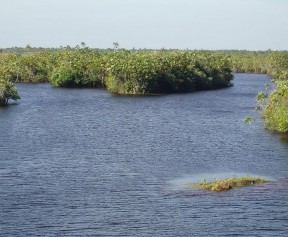
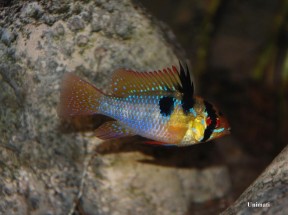



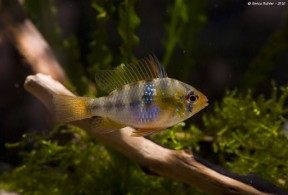



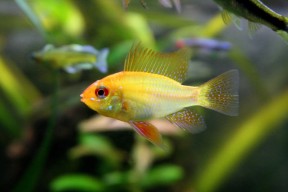


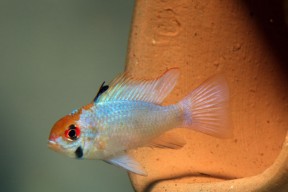
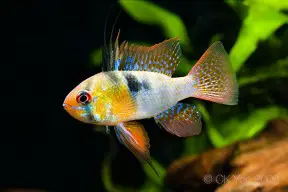


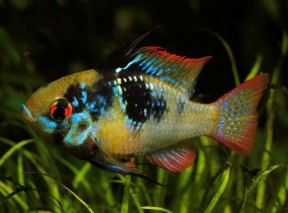


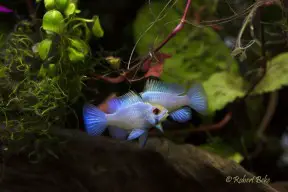
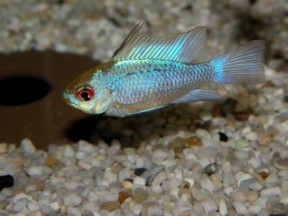

May 6th, 2013 at 8:41 pm
My favorite fish 🙂 thanks for all the very detailed info!
November 29th, 2013 at 2:27 am
I bought a couple of them like a month ago. They are still little, and apparently a male and a female. Notwithstanding, their colors are still very pallid and poor. I fed them with Tetra Color, but still they are very “feeble”, nonetheless they seem to be healthy. What is happening? Can you help me?
November 30th, 2013 at 1:21 am
Make sure that the water is soft and acidic enough. The lower you go, the better they are. Feed them with frozen food: artemia, glassworm, daphnia, moina. Use flakes only once, or twice a week. They are a suplement that will add vitamins to the diet.
If You want to see them fully colored, it’s imperative that You use sand on the bottom of the aquarium. Sifting sand is the basic of dwarf cichlids hygene. Be sure not to stain water too much.
They are not a black-water species, and prefer nice, covering vegetation.
Also I strongly encourage You to see Ivan Mikoljis video: “Natural aquarium”, which is about fish from Venezuela.
November 30th, 2013 at 1:23 am
!
Also add dried leaf litter to the bottom of the tank, as it will enchance the diet with plant matter.